Cell Death & Disease ( IF 8.1 ) Pub Date : 2020-03-18 , DOI: 10.1038/s41419-020-2392-5 Delphine Hoorelbeke , Elke Decrock , Maarten De Smet , Marijke De Bock , Benedicte Descamps , Valérie Van Haver , Tinneke Delvaeye , Dmitri V. Krysko , Christian Vanhove , Geert Bultynck , Luc Leybaert

|
Radiotherapeutic treatment consists of targeted application of radiation beams to a tumor but exposure of surrounding healthy tissue is inevitable. In the brain, ionizing radiation induces breakdown of the blood–brain barrier by effects on brain microvascular endothelial cells. Damage from directly irradiated cells can be transferred to surrounding non-exposed bystander cells, known as the radiation-induced bystander effect. We investigated involvement of connexin channels and paracrine signaling in radiation-induced bystander DNA damage in brain microvascular endothelial cells exposed to focused X-rays. Irradiation caused DNA damage in the directly exposed area, which propagated over several millimeters in the bystander area. DNA damage was significantly reduced by the connexin channel-targeting peptide Gap26 and the Cx43 hemichannel blocker TAT-Gap19. ATP release, dye uptake, and patch clamp experiments showed that hemichannels opened within 5 min post irradiation in both irradiated and bystander areas. Bystander signaling involved cellular Ca2+ dynamics and IP3, ATP, ROS, and NO signaling, with Ca2+, IP3, and ROS as crucial propagators of DNA damage. We conclude that bystander effects are communicated by a concerted cascade involving connexin channels, and IP3/Ca2+, ATP, ROS, and NO as major contributors of regenerative signal expansion.
中文翻译:

Cx43通道和通过IP 3 / Ca 2+,ATP和ROS / NO发出的信号将辐射诱导的DNA损伤传播至未辐射的脑微血管内皮细胞
放射治疗包括将放射束定向应用于肿瘤,但不可避免地要暴露周围健康组织。在大脑中,电离辐射通过对大脑微血管内皮细胞的影响而导致血脑屏障的破坏。直接辐射的细胞造成的损害可以转移到周围未暴露的旁观者细胞,这就是辐射诱发的旁观者效应。我们调查了连接蛋白通道和旁分泌信号传导在暴露于聚焦X射线的脑微血管内皮细胞中的辐射诱导的旁观者DNA损伤中的参与。辐射在直接暴露的区域引起DNA损伤,并在旁观者区域传播了几毫米。连接蛋白通道靶向肽Gap26和Cx43半通道阻滞剂TAT-Gap19显着降低了DNA损伤。ATP释放,染料吸收和膜片钳实验表明,辐照后5分钟内,在被辐照区和旁观者区都打开了半通道。旁观者信号涉及细胞钙2+动力学和IP 3,ATP,ROS和NO信号传导,其中Ca 2 +,IP 3和ROS是DNA损伤的关键传播因子。我们得出的结论是,旁观者效应是通过涉及连接蛋白通道的协同级联来传达的,并且IP 3 / Ca 2 +,ATP,ROS和NO是再生信号扩展的主要贡献者。











































 京公网安备 11010802027423号
京公网安备 11010802027423号